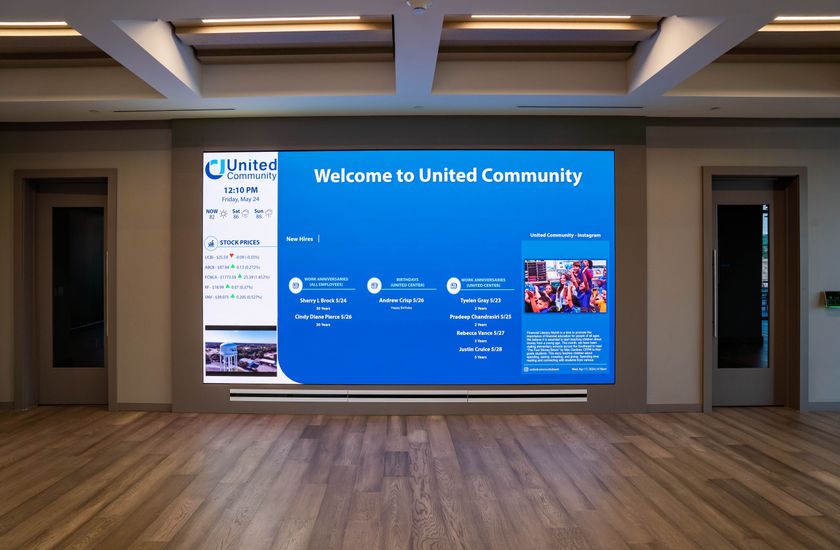- Probably the most interesting new application on view at InfoComm last week was one that has jumped from the consumer side to the commercial AV side of the fence: 3D, using just one projector. Big-gun 3D-ready projectors have been available from other manufacturers for the past couple years–Barco, Christie, Digital Projection, projectiondesign in the DLP camp, and offerings from a variety of players in the LCD camp that use two projectors– but new at this year’s InfoComm: New, inexpensive 120Hz time-sequential 3D compatible projectors that use just one projector, and will ship later this year, from various manufacturers: BenQ, Mitsubishi, Optoma, Sharp, Viewsonic (and Infocus with an update of a unit previously released). And bringing up the front, new generation high-res, higher brightness one-projector solutions from Digital Projection, and projectiondesign.
- The MP772 ST projector from BenQ’s displays both 2D and 3D content, at 2500 ANSI lumens, and XGA resolution.
- The Mitsubishi XD600U is the first projector in Mitsubishi's line designed with the latest DLP DDP2230 and “DLP Link” chipset, making it 3D-ready. The XGA-resolution projector is 4500 lumens.
- Sharp showed a prototype BrilliantColor 3-D DLP model. Using 3-D shutter glasses with 120 Hz refresh rate for flicker-free images, the projector is designed to offer compatibility with both 3-D and 2-D content.
- All of these 3D-ready projectors, and the units at InfoComm from Infocus, Optoma, and Viewsonic, are “3D-ready” because Texas Instruments has begun offering a firmware upgrade to its customers that enables 120Hz– 60Hz full-res image to each eye– projection. Hence DLP projector manufacturers are coming to market with products that are competitive in the education market in particular, where 3D has many applications in teaching. All users need: a PC with a standard graphics card that can output 60Hz, or a 120Hz graphics card and of course 3D content from a PC (or, coming down the road, 3D Blu-ray).
- Key to being is 3D-ready is TI’s “DLP Link”, a new system that syncs–using a photo diode in the glasses that is reading the screen– the stereo switching to the content (instead of using an IR emitter to achieve this). This is now possible with DLP because 120Hz is fast enough that you can take down time in the processing, and use that extra speed, or bandwidth, to put in an extra layer to communicate back to the glasses with the sync signal. And for the education market, shutter glasses are now readily available from a variety of makers like XpanD, or in a bundled deal from RealD. (Some users may still want to use an emitter, which is still possible, as DLP is sync-agnostic.)
- Also, the higher end of 3D with DLP projection was in evidence at InfoComm. The possibilities in the museum market, and the university market are great, with systems that provide large screen, high resolution imagery for the most demanding application.
- Norway’s projectiondesign is using InfoComm 09 to demonstrate a broad range of 3D stereoscopic projection solutions. A year ago projectiondesign, of Norway, made headlines with the debut of the F10 AS3D active stereoscopic projector at InfoComm 2008 in Las Vegas, and they were demonstrating the unit at InfoComm this week in Orlando.
- “We are seeing more and more end-users in the commercial space realizing that 3D can benefit their productivity and the accuracy of their work. This is happening not just in traditional applications such as industrial and military, but in new markets that we are already working with like digital signage, gaming design, medical, education, and VFX and post production,” said Anders Løkke, International Marketing and Communications Manager at projectiondesign.
- At the higher brightness, high resolution end, Digital Projection also had a big presence at InfoComm. DP had five TITAN 3-chip DLP 3D units in action all over the booth, from the 3D theater to the Low Latency pod to the Mechdyne immersive 3D pod (the one where you could look 360 degrees at the motorcycle- very cool). DP also launched TITAN and LIGHTNING WUXGA 3D models (plus other 3D models) at the show as well, so they have a 3D line-up of around twenty-five distinct displays as of last week.
- Fun, and the curiosity of students and teachers will drive 3D in the education market. And the possibilities for 3D in digital signage are huge. And visualization, simulation markets, go without saying. And even corporate applications of 3D for those willing to think outside the PowerPoint box, are coming Those are big drivers, and they represent real growth opportunity for AV integrators with the vision to offer new display options for their customers.
Single-Projector 3D Arrives at InfoComm
More about expert opinions


